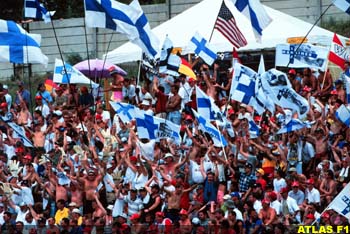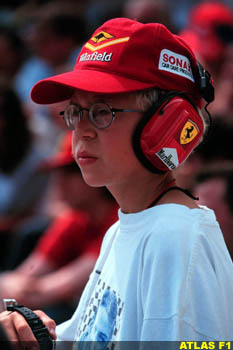|
Traveling to a Grand Prix? Atlas F1 offers some tips for the newbies and experienced alike, on making the most of your F1 race ticket
 Taking in a Formula One Grand Prix live is a sensational experience. The vibrant colours of the racing cars, the shrieking of the engines, the hair-raising, audacious moves of the best drivers in the world, and the reactions of tens of thousands of F1 aficionados must be experienced at least once in a lifetime at trackside. However, Grand Prix spectating must be planned carefully in advance. Taking in a Formula One Grand Prix live is a sensational experience. The vibrant colours of the racing cars, the shrieking of the engines, the hair-raising, audacious moves of the best drivers in the world, and the reactions of tens of thousands of F1 aficionados must be experienced at least once in a lifetime at trackside. However, Grand Prix spectating must be planned carefully in advance.
The most obvious first move is to prepare a budget that includes sufficient money for travel, tickets, souvenirs, meals and accommodation, as well as a mini-fund to cover contingencies and small emergencies. Travel agents offer special packages approved by the FIA (Fédération Internationale de l'Automobile); these will include air or other distance travel, accommodations and, often, ground transportation to the site, an important consideration because some circuits are far from major centres and difficult to reach. Getting to the site may seem a minor consideration going into race weekend, but getting back to your hotel or making sure you get your flight home after the race will be a major importance.
On site, bear in mind that the most expensive tickets are not necessarily those providing you with the best view.
The seats located in front of the start/finish line allow you to watch the frantic work performed in the pit lane. Seats located nearby a corner or in front of a hard braking zone will provide you with a superb view of the cars driven to their limits. Sitting in the lower rows will bring you closer to the cars while sitting high will give you a wider view of the action. Ticket availability and your personal preferences enter into play here.
 Numerous giant TV screens are installed around every Grand Prix circuit. If you are interested in following the action from other parts of the circuit or in watching slow-motion replays of incidents, find a seat located near one of the screens. Numerous giant TV screens are installed around every Grand Prix circuit. If you are interested in following the action from other parts of the circuit or in watching slow-motion replays of incidents, find a seat located near one of the screens.
Dress smart
Weather dictates the clothes you should wear at the track. It may be chilly in the morning but steamy by noon, so "layering" is a good way to go. Bring a bag with extra clothing if you need to take one layer off or add one on, and do not forget a raincoat and an umbrella if rain is in the forecast. Slip in your most comfortable shoes because there are strong possibilities that the car or bus parking lots are distant from your grandstand.
Carry your daily supplies in a backpack containing most if not all of the following: minor medical supplies such as good quality sun screen and a pain reliever, a hat, sunglasses and a few bottles of water. Ear protection is essential because Formula One cars blast by just metres away from you, so invest in earplugs or special earphones.
Binoculars of 8 x 23 power will allow you to see the cars, the passing manoeuvres, the spins and the pit stops up close. A good, pocket-size, point-and-shoot camera is a necessity, but please remember that the flash unit on this apparatus is next to useless. The silliest sight at a major sports event is the diamond-like twinkle of flashes on pocket cameras, especially considering these units are designed to illuminate an area of approximately 10 to 30 feet from the shooter and their users are often 10 times that distance removed from the action. If you have proficiency with a single-lens reflex camera, study your f-stops and bring high-speed film, the kind used by the pros, and you'll be agreeably surprised by the results.
A small radio is also welcomed because most Grand Prix circuits broadcast their public announcing system on the air; a radio is one of the most efficient ways to keep in touch with the latest news at trackside.
During the weekend
 Spectators at Grand Prix races often will "participate" in a race in their own way. Spectators at Grand Prix races often will "participate" in a race in their own way.
With race programme in hand, quickly try to identify each competitor not by the race number on the car, but by the driver's helmet. Keep in mind that each team usually runs two identical cars at high speed, so driver helmets are your best point of reference.
When a car exits a corner, the regular changes in engine sound indicate when the driver is changing gears. If you sit in front of a braking zone, look carefully and locate where each driver lifts his right foot from the throttle and starts applying the brakes. The large, white braking boards, numbered 200, 100 and 50, and the marshal posts are useful points of reference. When a driver is braking really hard, look carefully inside the wheels and you will see the carbon fibre disc brakes glowing orange. They are reaching temperatures of up to 1,000 degrees Fahrenheit. The fastest drivers are capable of braking exceptionally late without losing control of their cars.
The experienced Formula One spectator will trust his or her ears as much as eyes to acquire information during a race.
When a car accelerates out of a corner, listen to the engine. A sudden rise in engine pitch signifies that the rear tyres have lost traction and started spinning. Wheel spin is extremely time consuming and must be avoided. Traction control devices are forbidden in Formula One so it is the driver's responsibility to avoid, if not to limit, wheel spin.
 Braking is also crucial in all road racing categories. Locking up the wheels under braking causes much damage to the tyres. When a tyre stops rotating while the car is still moving, it creates flat spots - the tyre is no longer perfectly round. Flat spots causes destructive vibrations and terrible handling problems, forcing the driver to slow down or even to pit for fresh tyres. Braking is also crucial in all road racing categories. Locking up the wheels under braking causes much damage to the tyres. When a tyre stops rotating while the car is still moving, it creates flat spots - the tyre is no longer perfectly round. Flat spots causes destructive vibrations and terrible handling problems, forcing the driver to slow down or even to pit for fresh tyres.
Your own statistics
Timing drivers is particularly satisfying for some fans, and gives them a sense of truly participating in a race. Official timing boards provide lap times for the entire circuit. You may time the cars throughout the section of the track that lies in front of you. Write down the names and the times, and compare them to the full lap times once the session is finished. The fastest drivers around the entire circuit may not be those who were the quickest throughout your section. During the race, you may also keep track of the gap that separates your favourite driver from his pursuer or from the competitor who is directly in front of him. Interval timing will instantly tell you if your driver is making progress or losing ground.
Another very interesting task to perform during a Grand Prix is filling out a lap chart. Such a chart is often included in the race programme. A lap chart is designed to keep track of the position of every competitor. It is a large grid in which you write down the cars' numbers in their running order. The first column is for the opening lap of the race. The number of the leading car appears on top of the first column and is followed by the numbers of the following cars. You switch column every lap. A lap chart is a precious means of keeping track of the passing manoeuvres and of following a Grand Prix with great accuracy.
| 
